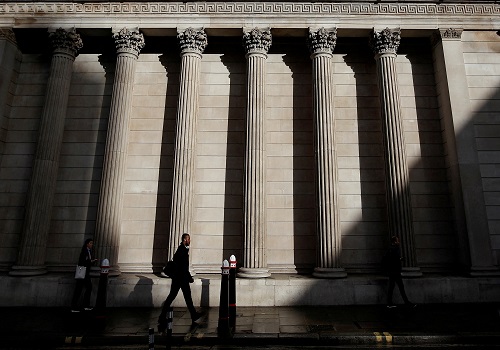Economy Update - FY22 GDP growth is revised down again and now stands at 8.7% By Emkay Global

Follow us Now on Telegram ! Get daily 10 - 12 important updates on Business, Finance and Investment. Join our Telegram Channel
Rocky road ahead
* FY22 GDP growth is revised down again and now stands at 8.7% (8.9% earlier), with Q4 growth slowing further to 4.1% amid a mild Omicron effect and an unfavorable base effect. For Q4, private GVA growth remained steady albeit low at 3.2%. The expenditure side showed dismal private consumption, while government consumption and GFCF improved. For FY22, nominal GDP rose by a whopping 19.5% vs. -1.4% in FY21, implying a deflator of ~10% in FY22.
* All sub-sectors, barring trade, transport and communications, have crossed pre-Covid levels by endMarch’22 (still 10.3% lower than the pre-pandemic level), while private consumption is merely up 1% from pre-Covid levels. Public spending remains the major growth contributor for a second consecutive year.
* We slash our FY23 GDP growth estimate by 80bps to 7.0%. The evolution of geopolitical reverberations and the magnitude of the energy supply shock are uncertain. This implies a protracted shortage of critical inputs, higher costs, shrinking corporate profitability and demand-curbing global policies. This will put pressure on the domestic growth story, which is yet to be broad-based and still lacks the next lever of secular growth.
Q4FY22 in line with expectations, albeit slows from Q4, led by manufacturing
India’s growth slowed in line with expectations to 4.1% in Q4FY22 (Emkay: 3.95%; Consensus: 3.9%), reflecting a concoction of unfavorable base effect and consolidation of activity. On the production side, the GVA growth at 3.9% was led by industrial sector slowdown. Growth plunged in manufacturing, partly due to supply-chain disruptions, led by the auto sector and sequential easing in corporate profitability, driven by rising input costs. Construction rose 2.0% while electricity demand was resilient. Services slowed amid Omicron-related curbs, especially in contact-intensive services in Q4, with public spending being its linchpin. Services’ contribution to growth also slowed, led by trade hotels and T&C. Agricultural growth rose 4.1%, but the heat wave impact could be visible in Q1FY23. Private GVA growth remained steady albeit low at 3.2%. The expenditure side showed dismal private consumption, while government consumption and GFCF improved, and net exports remained a drag despite healthy prints, albeit lower than Q3.
FY22 growth now revised down to 8.7%
For FY22, the GDP print at 8.7% (CSO’s estimates: 8.9%; Emkay: 8.7%) reversed the 6.6% contraction of FY21. The supply-side estimates depict that agriculture remained steady at 3.3%, while industry (10.3% vs. -3.3% in FY21) and services (8.4% vs. -7.8% in FY21) fully reversed the contraction seen in FY21. Within industry, manufacturing was robust at 9.9%, services growth was led by public admin and other services, growing close to 12.6%, while trade, transport and communications also printed ~11% - however it is the only sector that is still 10.3% lower than the prepandemic level. From the expenditure side, private consumption and GFCF grew robust in FY22 on a low base, while government consumption was much lower, in contrast with the production side. For FY22, growth in the GDP deflator increased to 10% from 5.6% in FY21, and nominal GDP grew by 19.5%.
The growth pressures likely to worsen…
Back home, incoming data, even though slowing, remains healthy. Amid a revival in urban demand, contact-intensive services are improving, and rural demand has seen some recovery amid better terms of trade. Meanwhile, labor absorption in manufacturing and services is rising, capacity utilization is improving, and there are signs of new investment gradually coming in. Investment activity is gaining momentum with higher capacity utilization and capital goods production registering an uptick. Yet, the momentum of the recovery is still below full strength, warranting policy support. Meanwhile, the geopolitical drag seems to have materially changed the energy order. The global price disruptions reflect a confluence of China slowdown, protracted shortage of critical inputs, extended war in Europe and demand curbing global policy actions. All of this poses downside risks to domestic economic activity.
…. Making us further slash FY23 growth estimate by 30bps to 7%
Even as the recovery in domestic economic activity is yet to be broad-based, going ahead, the effective fiscal policy impulse may be limited, and financial conditions led by monetary stance will only tighten ahead. We now see India’s growth slowing to ~7.0% in FY23 from 7.3%. We still see that the next lever of secular growth is missing, implying a consistent need for policy support. Private economic agents are unlikely to lead the growth story.
India’s golden period of secular growth of 2003-07 was synced with the capex cycle pre-GFC. Consumption, specifically private consumption, has been the linchpin of India’s growth story post GFC, but it has been languishing since 2018 and has seen a secular hit since then. Private investment, on the other hand, is endogenous in nature -- it first needs demand to fire and utilization to rise. Meanwhile, effective fiscal impulse has been limited post Covid (much like most EMs), unlike in DMs where the revenue expenditure multipliers have been strong. This, in conjunction with higher global uncertainty, sustained supply disruptions, higher input costs, lower corporate profitability and tighter policy reaction function of the RBI, will further curb domestic demand.
To Read Complete Report & Disclaimer Click Here
For More Emkay Global Financial Services Ltd Disclaimer http://www.emkayglobal.com/Uploads/disclaimer.pdf & SEBI Registration number is INH000000354
Above views are of the author and not of the website kindly read disclaimer










Tag News

Monthly Debt Market Update, September 2023: CareEdge Ratings





 320-x-100_uti_gold.jpg" alt="Advertisement">
320-x-100_uti_gold.jpg" alt="Advertisement">








